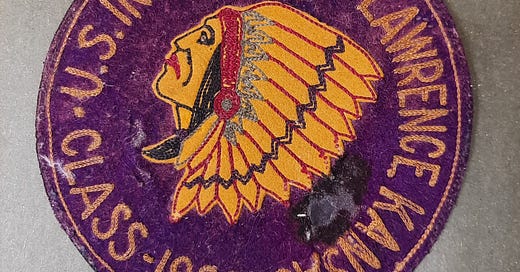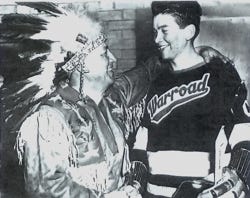In the archives of the Warroad Heritage Center, I came across this 1929 letter sweater patch from the Haskell Institute in Lawrence, Kansas, which had belonged to Max Jones, Namaypoke’s grandson.1
In the spring of his first year on campus, Jones competed for the US Olympic track team in 1927. He didn’t make the final cut, but he lettered in track at Haskell.
I once ran the 100 yard dash in 9.9 seconds but the timekeeper would give me credit for only 10 seconds because he claimed I had a strong wind at my back.2
Born March 22, 1908, to Anna Namaypoke and her Scottish-Métis husband, John Jones, Max grew up in Warroad. He had a sister, Sally, who was two years younger. They lived on the 7-acre parcel along the river where his maternal grandfather Namaypoke was buried in 1916.
When I enrolled in the Warroad school, I could not speak a word of English…but my grandfather encouraged me to learn the white man’s language so that I could read, write and speak English to help my people.3
Max attended Warroad public school and excelled in sports. He won first place in the half-mile at the state championship for track and field in 1925 and was a member of the winning relay team from Warroad High School. But he was expelled, according to the story he told his son Roy Jones, for a Halloween prank.
His senior year, 1926-27, Jones went to Baudette High School, where he played on a winning basketball team.
When he graduated high school, his mother, Anna Jones, signed and submitted his application for college enrollment to the Superintendent of Red Lake Indian Agency. The superintendent approved his application to the Haskell Institute for him to start in the fall of 1927.
Haskell Institute opened in 1884 as a US Indian Industrial Training School, similar to the Carlisle Indian School in Pennsylvania established by Captain Richard Henry Pratt. His original intent was to “Americanize” students by stripping them of their native language and culture, and preparing them for employment.

Max’s freshman year, 1927-1928, was the first year Haskell offered post high school courses. Today Haskell Indian Nations University is a public tribal land-grant university and the oldest continually operating federal school for American Indians.
When Max was a student there, one of his teachers encouraged him to develop his artistic skills and he graduated with a degree in Mechanical Drawing. When he returned home to Warroad, he met Eunice Craig from Roseau and they married on June 12, 1930.
After the wedding, Max and Eunice moved to Michigan, where Max worked in an automobile plant and they started a family with eldest daughter Jean, and then a son Robert. The Jones family returned to Lake of the Woods and lived on the seven-acre parcel on the Warroad River where Namaypoke was buried.
When they first came back to Warroad, they lived with his widowed mother, Anna, on one side of the house originally built for Namaypoke in 1915. On the other side, divided with a curtain for a wall, lived Max’s sister, Sally, and her husband Joe Oshie and their young family. Sally and Joe named their first-born son Max after his uncle.
Max’s second son, Roy, was born there in 1936. And then Max and Eunice had two more daughters: Maxine and Mary.
Roseau County employed Max as Recreation Director for the City of Warroad and the towns of Swift, Salol, and Roosevelt. He coached baseball, basketball and hockey, taught swimming and was the first hockey coach at Warroad High School.
When the Japanese bombed Pearl Harbor on December 7, 1941, seven men from Warroad, including Jones, went together to enlist the following day. Six went off to war. In an odd twist of fate, the legendary athlete failed his physical exam.
In 1943, Max and Eunice and their five children moved to International Falls where Jones took a job at the Insulite Plant, a division of the Minnesota and Ontario Paper Company which manufactured pressed boards from pulp used for insulation in home construction. He started out on the factory floor but when his supervisor learned he had a degree in Mechanical Drawing, management moved him to a position as a draftsman. He continued to work for the MANDO (Minnesota and Ontario Paper Company) as an assistant surveyor of timber lands.
In 1944, Max moved his family to Ponemah on Red Lake Reservation while he traveled for his job. Ponemah, Minnesota, sits between Lower and Upper Red Lake. His wife and kids lived on the reservation while he spent a year surveying in McIntosh, Minnesota, about 80 miles southwest of Ponemah.
The following year, he moved his family back to Warroad while he spent the next three years working in Alaska as an assistant surveyor. Efforts to make the Alaska Territory an official state began to ramp up in 1943. Even though it wouldn’t be until 1959 before Alaska achieved statehood, the prospect of access to lands rich in timber provided employment for someone accustomed to long cold winters. When Max Jones came home to Warroad, he came home to hockey.
Jones accompanied the high school hockey team down to the state championship in 1948. “Dressed in his feathered head dress, beaded buckskin jacket and other finery of an Indian chieftain, Max Jones led the Warroad High School Warriors into battle at the St. Paul Auditorium.”4
He came to cheer on Max Oshie, his sister Sally’s eldest son Max, who played center on the team with Alvin “Buster” Oshie, George Angus, and Sam Gibbons – all blood relations to Namaypoke.
Jones was 46 years old when he learned his name would never be on the deed to his grandfather’s land. In 1954, Maynard Nelson outbid him when the last piece of Namaypoke’s allotment had been approved for sale by the Bureau of Indian Affairs. Nelson paid $727. Correspondence from Warroad Attorney Bert Hanson had revealed Max Jones bid $450.
It wasn’t long after the sale of land when Max Jones first began to exhibit symptoms of early onset dementia. He was diagnosed with Pick’s disease — similar to Alzheimer’s, but a less common frontotemporal neurodegenerative disease — in 1955 at age 47.5
Tragically, and possibly a result of his symptoms, Max Jones was killed when a car hit him crossing the road in International Falls in 1965. He is buried in Riverside Cemetery in Warroad, across the Warroad River from where he grew up on Namaypokes’s allotment land.
Sources I used here include newspaper clippings from Max Jones files at the Warroad Heritage Center, Alvin (Ole) Swanson’s Warroad Natives: The Chippewa (1975), Henry Boucha’s Henry Boucha, Ojibwa, Native American Olympian (2013), and extensive interviews with Roy Jones, his son.
Max Jones quoted by Timothy Oshie, “A Warroad Sports Legend…Max Jones,” Warroad Pioneer, September 27, 2006: 13.
Max Jones quoted by Timothy Oshie, “A Warroad Sports Legend…Max Jones,” Warroad Pioneer, September 27, 2006: 13.
Max Jones quoted by Timothy Oshie, “A Warroad Sports Legend…Max Jones,” Warroad Pioneer, September 27, 2006: 13.
Timothy Oshie, who wrote the biographical profile of his maternal grandfather, died from complications of the same illness on May 4, 2021, at the age of 56. His son, T.J. Oshie, plays in the NHL for the Washington Capitals.









I know they must be very grateful for all of your hard work with this research, but what I also mean is I'm interested in how what you are discovering makes them "feel" about their history, that is, what is their emotional response? The kind of things they are asking and sending tells me they want to be contributors to this history. It matters.
Well told Jill. I love your thorough research in honouring these stories.